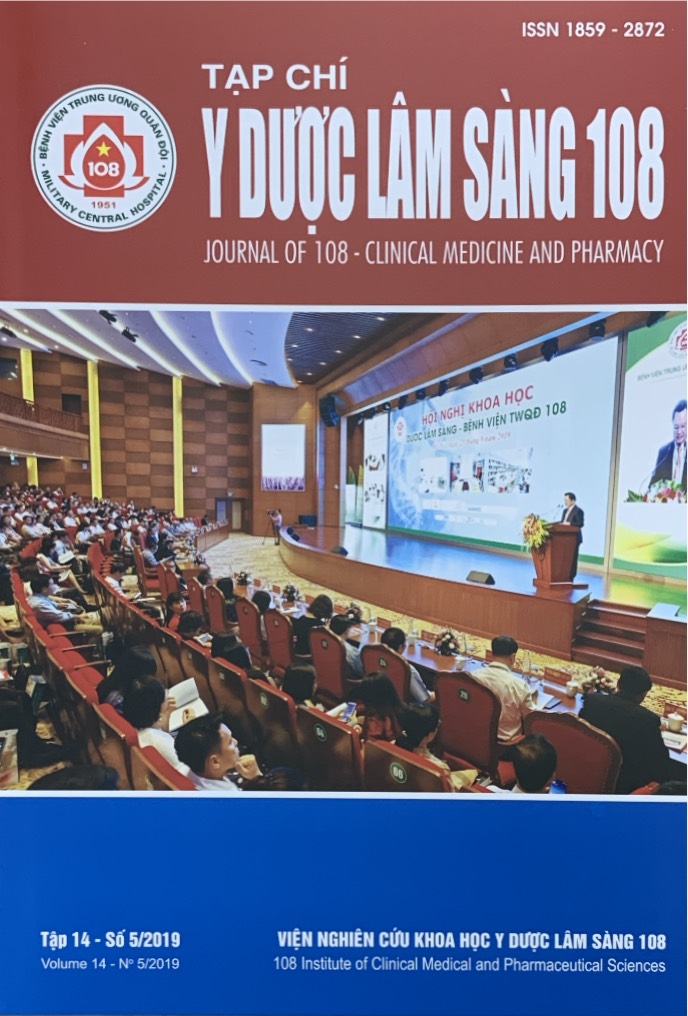Nghiên cứu điểm thuốc vận mạch - cường tim sau phẫu thuật thay van hai lá
Main Article Content
Keywords
Tóm tắt
Mục tiêu: Đánh giá điểm thuốc vận mạch - cường tim (VIS) sau phẫu thuật thay van hai lá và giá trị tiên lượng của VIS. Đối tượng và phương pháp: Nghiên cứu tiến cứu, mô tả cắt ngang 67 bệnh nhân được phẫu thuật thay van hai lá. Tính giá trị trung bình điểm thuốc vận mạch - cường tim lớn nhất trong 24 giờ đầu (VISmax) khi về hồi sức, so sánh giá trị tiên lượng với các yếu tố tiên lượng tử vong. Kết quả và kết luận: VISmax trung bình: 8,3; VISmax có diện tích dưới đường cong 0,997. VISmax khác biệt có ý nghĩa thống kê giữa hai nhóm có và không có biến chứng sau phẫu thuật thay van hai lá. Điểm cut-off 32,5 với độ nhạy 100% và độ đặc hiệu 98,4%. VISmax có diện tích dưới đường cong lớn nhất trong các yếu tố tiên lượng tử vong ở bệnh nhân sau phẫu thuật thay van hai lá.
Article Details
Các tài liệu tham khảo
2 Garcia RU, Walters HL, Delius RE et al (2015) Vasoactive inotropic score (VIS) as biomarker of short-term outcomes in adolescents after cardiothoracic surgery. Pediatr Cardiol 37(2): 271-277.
3. Gaies MG, Jeffries HE, Niebler RA et al (2014) Vasoactive-inotropic score is associated with outcome after infant cardiac surgery: An analysis from the pediatric cardiac critical care consortium and virtual PICU system registries. Pediatr Crit Care Med 15(6): 529-537.
4. Koponen T, Karttunen J, Musialowicz T et al (2019) Vasoactive-inotropic score and the prediction of morbidity and mortality after cardiac surgery. Br J Anaesth 122(4): 428-436.
5. Bojar RM (2011) Perioperative care in aldult cardiac sugery, 5th ed. Wiley-Blackwell, West Sussex.
6. Lomivorotov VV, Efremov SM, Kirov MY et al (2017) Low cardiac output syndrome after cardiac surgery. Journal of cardiothorac vascular anesthesia 31(1): 291-308.
7. Nashef SAM, Roques F, Michel P et al (1999) European system for cardiac operative risk evaluation (EuroSCORE). European Journal of Cardio-thoracic Surgery: 169-213.
8. Poterucha JT, Vallabhajosyula S, Egbe AC et al (2019) Vasopressor magnitude predicts poor outcome in adults with congenital heart disease after cardiac surgery. Congenit Heart Dis 14(2): 193-200.
9. Kim JW, Gwak M, Shin WJ et al (2015) Preoperative factors as a predictor for early postoperative outcomes after repair of congenital transposition of the great arteries. Pediatr Cardiol 36(3): 537-542.
10. Rudolph AM (2009) Congenital diseases of the heart: Clinicalphysiological considerations, 3rd ed. Wiley, Chichester, Hoboken.
 ISSN: 1859 - 2872
ISSN: 1859 - 2872
